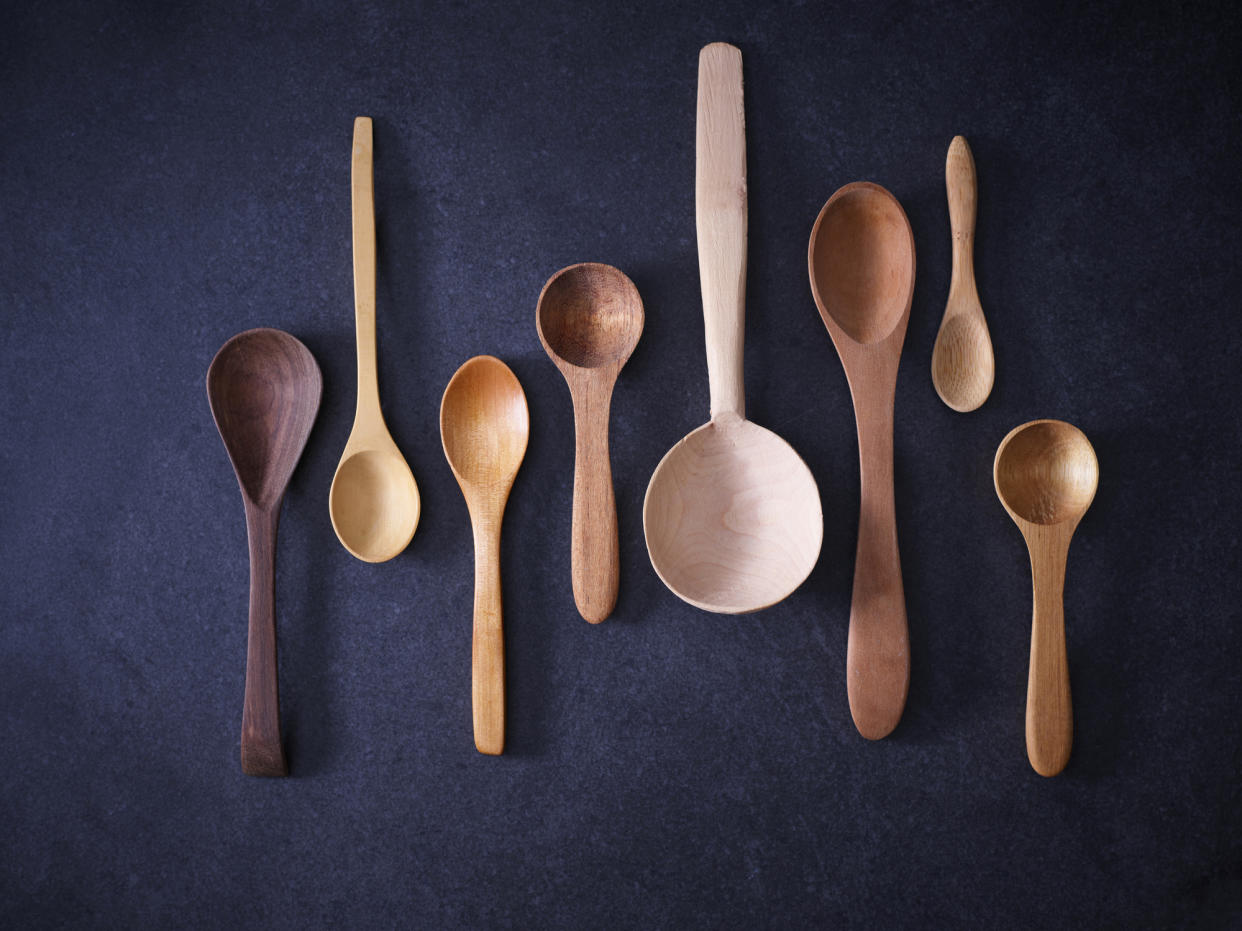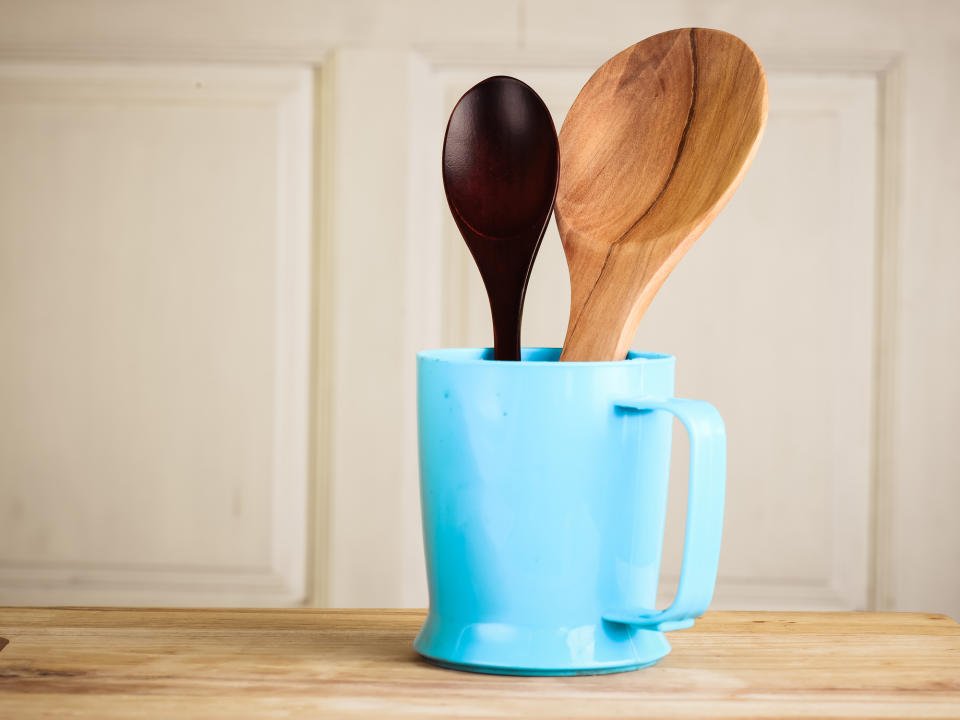Your wooden spoons are probably dirtier than you think. Here's how to clean them

From getting our bake on, to using them to stir the stew in the slow cooker, the humble wooden spoon is something of an unsung kitchen hero.
But because we use them so much, wooden spoons are probably prone to getting a little grubbier than some of our other kitchen staples.
And even though we stick them in the dishwasher or give them a daily scrub, a simple hack has revealed our wooden spoons could actually be much dirtier than we think.
Former MasterChef Australia judge, Matt Preston, shared his "wooden spoon test" so home cooks can determine whether it is worth keeping your trusty spoon or throwing it away.
He suggests leaving your wooden spoon in a cup of boiling water for about 20 minutes, drawing oils out of the wood.
People have been trying it and sharing the results on social media and many have been left shocked by how dirty the spoons are even though they wash them every day.
Preston previously told Delicious: “On the surface a perfect present but stick an old one in a cup of boiling water to see what fate awaits all wooden spoons. Give it a sniff. Phew, stinky! And you were going to stir your custard with that.”
Read more: Why your washing machine might not be cleaning your clothes

Instead of your old faithful wooden spoon, he suggests using a silicon spatula.
“They’re hygienic, heat-resistant and flexible, so they are great for getting into the corner of a pan or getting every last skerrick out of a bowl,” he explains.
So why do wooden spoons get so dirty?
According to James Milnes, managing director at sanitiser brand Zoono, wooden spoons are more porous than plastic or metal alternatives.
“As a result, they are more likely to retain moisture or liquid,” he explains. “As a wide range of pathogens thrive on damp surfaces, this can cause them to become a haven for bacteria.
“Wood is also more likely to crack over time, allowing for bits of food and dirt to become stuck in the spoon itself.”
Watch: FDA warns viral avocado hack could make you sick
It’s therefore important to always clean your wooden spoon thoroughly after every use.
“If your spoon starts to look damaged with wear and tear, it’s time to invest in a new one,” says Milnes.
For those of us who are keen to give our trusty wooden spoons another go, there are ways to get them a little cleaner.
Read more: Are we washing our clothes too often?
How to properly clean wooden spoons
Chris Riley, recipe developer, culinary expert and founder of The Daring Kitchen has a whole wealth of kitchen-related cleaning knowledge under his belt and believes there are certain steps we can take to preserve the life of our wooden spoons for a little while longer.
“To clean a wooden spoon properly you have to hand wash it with hot soapy water (preferably quickly after each use),” he says.
Afterwards, he says we should pat it dry with a clean cloth and let it air dry before putting it away.
“If a wooden spoon sits in water for too long it will absorb water and expand, but when it dries it will contract and cracks may appear,” he adds.
According to Milnes, using high temperatures, over 60 degrees, while cleaning will kill most bacteria, but he also recommends using an anti-bacterial cleaning product to ensure it’s completely free from bacteria.
“Using an alcohol-free antibacterial product that does not use harsh chemicals is the best option as it will not damage the spoon,” he explains.
“Alcohol-based products will quickly dry them out, leaving them looking ‘fuzzy’ and causing them to crack.”
Read more: Woman shares time-saving life hack she uses when hanging out washing
It is important you consider not just cleaning the spoon but the space the spoon is kept in too.
“Germs and bacteria love to live in dark and damp places, so while the kitchen drawer keeps things neat and tidy, it’s the worst place to keep a wooden spoon, especially if it’s thrown in there still wet, straight from the dishwasher,” Milnes explains.
“Clean your cutlery draw thoroughly on a regular basis with a long-lasting anti-bacterial spray or microbe shield.
“And always make sure wooden spoons are completely dry before putting them back into the cutlery draw.
“UV light is extremely effective in killing a broad range of pathogens, so leave it out on the windowsill or on a naturally lit surface to dry.
“This also prevents any germs being transferred from your tea towel onto the spoon before it’s put away.”
Read more: How to clean an oven quickly: This top-rated kit will do the trick
Riley also has some tips for maintaining the wooden spoons in our kitchen drawers.
“To maintain the wooden utensils apply mineral oil to the wood every once in a while to prevent the wood from drying out and cracking.
“If the wood is cracked you should get a new spoon,” he adds.
And if your wooden spoon is starting to look a little stained, there’s a fix for that too.
“If the wooden spoon has gone fuzzy or stained you can take a piece of fine sandpaper and scrub it gently to fix it,” Riley explains.
“Afterwards, apply a food-grade mineral oil and rub it in with a cloth.”



